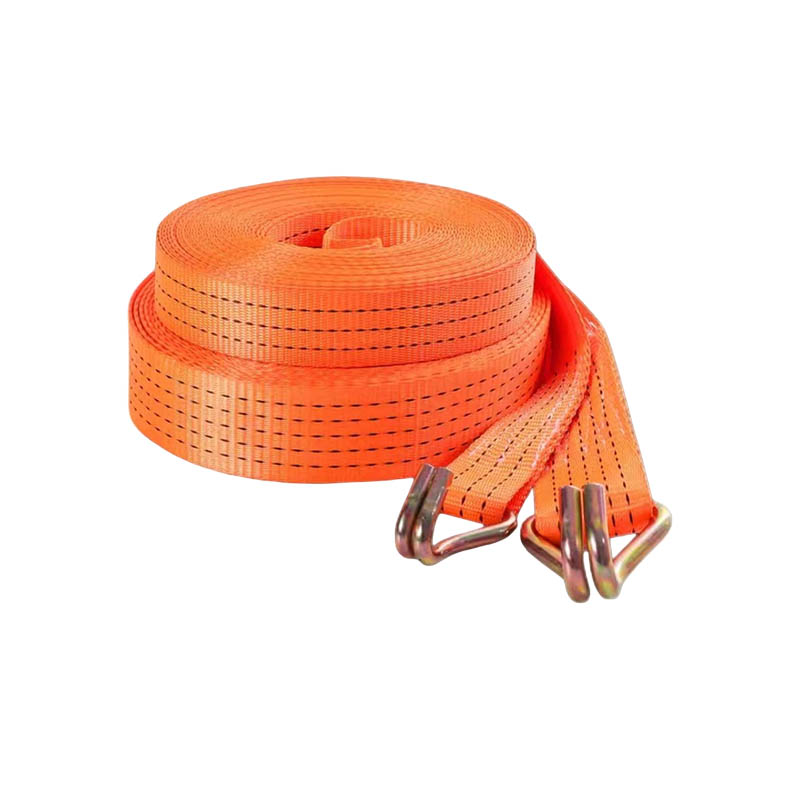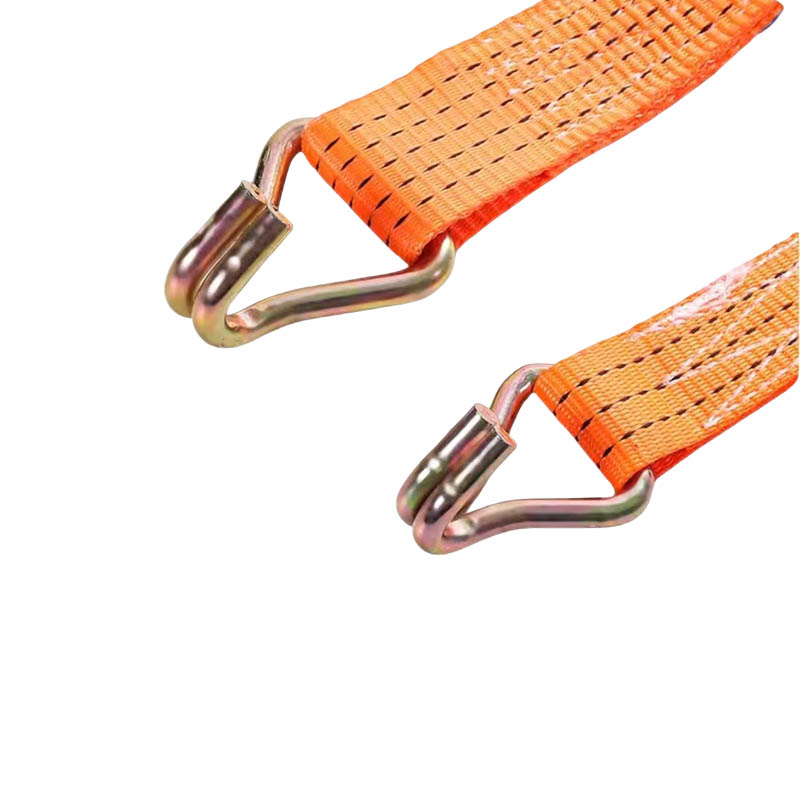
The hard core tension of industrial tension rope makes industrial equipment as stable as a rock
Publish Time: 2025-08-11
When Vibration Becomes an Invisible Killer in Industrial ScenariosIn a logistics warehouse, a box of precision instruments misaligned its internal components due to bumpy transportation; on a construction site, a pile of steel slipped from a truck due to insecure binding, nearly hitting a passerby; on an automated production line, a workpiece being processed was thrown from a robotic arm due to insecure securing, bringing the entire line to a halt...In industrial settings, cargo stability is never a trivial matter—it impacts safety, efficiency, and cost. A seemingly ordinary compression rope is the key tool to address this challenge.Compared to traditional ropes, industrial compression ropes (also known as lashing straps or cable ties) utilize mechanical structures (such as ratchets and levers) to achieve precise tensioning. With 300% increased wear resistance, a five-fold increase in service life, and applicable across 90% of industrial applications, they redefine the safety standard for cargo securing.I. Technical Analysis: How does a mechanical structure achieve rock-solid tension control?1. Ratchet + Lever: Replacing manual tensioning with "mechanical self-locking"Traditional ropes rely on manual knotting, making tension difficult to quantify and prone to loosening. The core of industrial compression ropes lies in the ratchet mechanism:One-way locking: The ratchet teeth engage with the grooves of the webbing/wire rope, tightening the grip more tightly with greater force, completely eliminating "springback" during transport.Effort-saving lever: By amplifying operating force through the lever principle, even female workers can easily tighten 10-ton loads.Visualized tension: Some high-end models feature a tension dial that can be precisely adjusted to preset tension values from 500kg to 10 tons.Use Cases:Glassware loading in logistics trucks: With the ratchet locked, even sudden braking prevents the glass from shaking or shattering.Transporting wind turbine blades: A lever structure secures 20-meter-long blades to a special vehicle frame, ensuring zero displacement during transit.Building formwork hoisting: A dial adjusts the tension to ensure precise alignment between the formwork and the steel frame.2. Webbing/Wire Rope: A Material Philosophy for Different ScenariosIndustrial compression ropes are made of two materials, each with its own specific advantages:High-strength polyester webbing:Advantages: Lightweight (only 1/3 the weight of steel wire rope), corrosion resistance (rust-resistant in acidic and alkaline environments), and low elastic modulus (deformation less than 2%, preventing constriction).Applicable Applications: Precision instruments, electronics, food, and other goods susceptible to pressure and scratches.Galvanized Steel Wire Rope:Advantages: Tensile strength of up to 1860 MPa (three times that of webbing), high-temperature resistance (withstands short-term temperatures of 200°C), and a service life exceeding 10 years.Applications: Heavy machinery, steel, concrete components, and other heavy cargo.Data Comparison:Material Weight (under the same tensile force) Corrosion Resistance Deformation Rate Service LifeHigh-Strength Webbing Lightweight Excellent <2% 5-8 YearsGalvanized Steel Wire Rope Heavyweight Good <0.5% 10-15 YearsII. Scenario Verification: From Logistics to Manufacturing, a Rope's "Safety Coverage"1. Transportation: Transforming a "Bumpy Road" into a "Smooth Road"Case 1: Cold Chain Pharmaceutical TransportationA pharmaceutical company once suffered damage to vaccines worth 2 million yuan during transportation due to inadequate traditional rope anchoring. After switching to industrial compression ropes:The ratchet mechanism secures the medicine box, ensuring displacement of less than 1cm even on bumpy mountain roads;The soft surface of the webbing prevents scratches on the aluminum foil of the vaccine packaging;Annual savings in loss and damage costs exceeding 1.5 million yuan.Case 2: Oversized Cargo TransportationThe wind turbine tower is over 80 meters long and weighs 120 tons. Traditional steel wire ropes require 10 people to operate simultaneously and are prone to scratching the tower surface. After switching to wide webbing compression ropes:The single webbing is up to 10cm wide, distributing the pressure and preventing localized deformation;The lever structure allows two people to complete the securing process, increasing efficiency by 80%;The galvanized coating prevents salt spray corrosion during transportation.2. Warehouse Management: From Manual Inspection to Intelligent Loose PreventionTraditional Pain Point: Warehouse shelves can tilt and collapse due to insecure securing, resulting in casualties and loss of goods.Solution: Industrial compression ropes equipped with smart sensors:Built-in tension sensors monitor the securing status of goods in real time.Abnormal tension (such as looseness or overload) automatically triggers an alarm and sends it to the administrator's mobile phone.After implementing this system at an automotive parts warehouse, the shelf collapse accident rate has been reduced to zero, and annual insurance costs have been reduced by 40%.3. Industrial Manufacturing: Eliminating Vibration Interference in Precision MachiningCase Study: Aircraft Engine Blade ProcessingBlades are only 2mm thick and require absolute stillness during machining. Traditional ropes can easily cause blade deformation due to vibration. Industrial compression ropes, however, utilize a highly rigid steel wire rope material that controls blade vibration to within 0.01mm. A ratchet mechanism ensures constant tension throughout the entire machining process, increasing product qualification rates from 85% to 99%.III. Cost Revolution: The Long-Term Value of a Rope1. 300% Improved Wear Resistance: From "Annual Replacement" to "Ten-Year Replacement"Traditional nylon ropes are prone to wear and breakage from frequent tensioning and loosening. Industrial compression ropes, however, feature webbing made of high-strength polyester and TPU coating, and galvanized steel wire ropes coated with PVC.Webbing wear test: 100,000 rubs on sandpaper without breakage (industry standard: 30,000). Wire rope corrosion test: 500 hours in salt spray environment without rust (industry standard: 200 hours). A steel company's actual test showed that a single compression rope has a service life five times that of traditional ropes, reducing annual procurement costs by 65%.2. Standardized Operations: From "Experience-Based" to "Process-Based"Traditional rope fastening relies on worker experience, resulting in frequent undertension and overload. Industrial compression ropes, on the other hand, offer:Using ratchet scales to quantify tension, new employees can be on-boarded in just 30 minutes. Standardized specifications reduce inventory management complexity, reducing the number of SKUs in one logistics company's warehouse from 20 to 5. By eliminating damage claims for goods caused by improper fastening, one e-commerce company's annual dispute rate has decreased by 70%.Safety is paramount: The "Industrial Aesthetics" of a RopeIn the industrial world, "stability" is the most underrated productivity factor. It makes logistics more efficient, manufacturing more precise, and warehousing safer. Industrial compression ropes, through sophisticated mechanical design and breakthroughs in materials science, transform the abstract concept of "stability" into a quantifiable, controllable, and reliable solution.From 1 ton to 100 tons, from -40°C to 200°C, from ground transportation to high-altitude lifting—the tension of this rope is supporting the "stability and happiness" of the industrial world.


